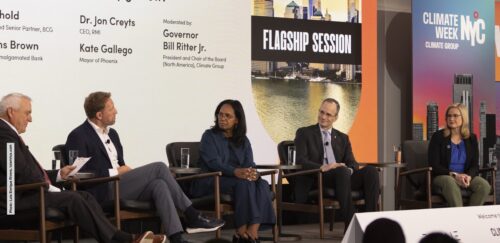
Private Sector Pushes Ahead at Climate Week NYC
A record turnout and a shift from federal funding to corporate leadership defined this year's gathering. Companies are digging in to solve practical challenges of the energy transition, from efficiency and transparency to scaling low-carbon industry.
Heading into this year’s Climate Week NYC, which ran Sept. 21–27, some anticipated a downbeat gathering. Where last year’s was elevated by IRA-era clean energy subsidies, this year, CWNYC attendees met in the wake of a comprehensive reversal of federal funding and policy support for clean energy.
But record-setting turnout defied any low expectations. With nearly 1,000 events and over 100,000 attendees, the scale and substance of the sprawling event told another story. While the shift to clean energy may be facing headwinds in the United States, growth is enduring, driven by rising demand for power and the cost advantages of deploying solar, wind, batteries, and other renewable energy solutions.
By many accounts, this CWNYC was the most global to date. With COP30, this year’s UN climate conference, slated to begin in November in Belem, Brazil, many attendees framed this CWNYC as an easier-to-attend alternative. And while Washington has again withdrawn from the global negotiation, other leaders are emerging: “There’s a sense of enthusiasm around other countries — India, Brazil, Mexico, China, and others — moving into a leadership position ahead of COP,” said Jon Creyts, RMI’s chief executive.
On the ground in New York, private sector priorities on energy, data centers, and competitiveness displaced past years’ focus on policy- and subsidy-led decarbonization as the key forces driving clean energy. Among RMI-ers , many conversations centered on the work needed to remove market barriers, such as better accounting standards (to assess and track company emissions), as well as technical steps to lower emissions from shipping, aviation, and other industries.
Even so, as companies continue to push ahead, many are doing so with less fanfare than in the past. “This year saw more closed-door events, an opportunity to have honest and real conversations about progress and barriers,” added Thomas Koch Blank, RMI managing director focused on industrial decarbonization.
“I am more confident than ever that the transition has reached escape velocity and is unstoppable even in the face of political volatility,” Koch Blank said. “It simply makes too much long-term economic sense for politics to topple.”
Between threading their way through Manhattan’s grid-locked streets during CWNYC, RMI-ers shared these snapshots.
The grid is the biggest investment opportunity being overlooked here in the U.S. We have pumped trillions into the grid over the years, and today it only operates at 40% capacity. To meet the load growth we are facing now and in the future, it’s about upgrading energy efficiency, supporting demand side resources, and delivering more incentives for innovation.
Jon Creyts: Most of the world is moving quickly to clean energy
Chief Executive Officer
At a CWNYC flagship session, Creyts emphasized the profitable opportunities clean energy offers at home, and overseas: “All of us on the panel were optimistic about the future, with 80% of the world still moving fast on the energy transition, plus strong subnational and corporate leadership here in the U.S.”
Energy efficiency was eerily absent from most discussions. The most cost-effective energy to supply is the energy not consumed. Efficiency upgrades can deliver disproportionate benefits by reducing or delaying capital expenditure, debottlenecking infrastructure, and enabling growth of electrified, high-value-added sectors.
Thomas Koch Blank: A missing focus on efficiency
Managing Director, Climate-Aligned Industries
Not far from the busy meeting venues at CWNYC, Koch Blank notes, the Empire State Building offers a towering example of the potential returns from investing in efficiency.
Starting in 2009, RMI had the privilege to work with the Empire State Realty Trust to design and implement a deep retrofit that optimized energy performance across the entire building — for example, by remanufacturing windows on site to let in light, but reflect heat — leading to more than a 50% reduction of both energy consumption and carbon emissions.
Learn more about RMI’s work on the Empire State Building here:
While it’s true some companies are pulling back on climate pledges, the bigger story is that many more are staying the course — some quietly doubling down on sustainability.
Ben Bartle: How to advance US clean energy competitiveness
Principal, Catalytic Finance
The reversal of federal support for clean energy manufacturing puts the United States at risk of falling behind in the race to build solar, batteries, and related technologies at home, Bartle notes. But the United States won’t beat big state-backed rivals in China at their own game.
Absent efforts to mobilize domestic output, the United States could face a $152 billion annual deficit in new energy technology by 2035, while China would be earning $340 billion in exports, according to a new RMI report co-authored by Bartle with Sarah Ladislaw (below) and others.
But America can stay in the race if it activates a range of competitive strengths:
- Balance US energy security with real competitiveness and resilient supply chains.
- Benchmark the right technologies and partners with hard data, and set disciplined, sector-by-sector priorities, moving beyond ad-hoc deals.
- Build execution muscle such as master energy agreements and empowered deal coordinators, and modernize and derisk trade finance (such as export-import banking) to mobilize US private capital and tech innovation focused on supply-chain resilience and energy security.
[Companies] want to have a share in producing clean energy technologies, selling them to the world. [They can profit from] the single largest capital formation in the history of the world.
Sarah Ladislaw: For businesses, unprecedented opportunity
Managing Director, US Program
In conversation with Axel Threlfall of Reuters and Drew Bond of C3 Solutions, Ladislaw spotlighted the economic urgency of the clean energy transition and the private sector’s pivotal potential to profit from it.
Clean energy, she emphasized, is not only a climate solution. It’s also increasingly the best pathway to transform and upgrade the global economy. For a deeper dive into the US role in the global clean energy race, explore RMI’s new energy statecraft playbook.
RMI has a history of working with ambitious companies to accelerate the adoption of low-emissions products, from the Sustainable Aviation Buyers Alliance (SABA)’s work on scaling the market for sustainable aviation fuel to the Sustainable Steel Buyers Platform’s ambitious plans for green steel.
Bryan Fischer: To scale clean cement, steel, concentrate demand
Managing Director, Industrial Decarbonization
At CWNYC, Fisher celebrated the launch of RMI’s latest demand initiative, Sustainable Concrete Buyers Alliance, a collaboration between RMI and the Center for Green Market Activation (GMA). SCoBA aggregates demand for low-carbon cement and concrete, the production of which accounts for around 8 percent of global carbon emissions every year.
For a comprehensive look at how smart procurement can reduce carbon pollution, check out RMI’s work on catalytic procurement.
There’s so much data exchange that’s happening in the carbon markets across the different stakeholders. We want to be able to make that data exchange happen as effectively and as efficiently as possible.
Bonnie Lei: To lift carbon markets, improve data transparency
Principal, Climate Intelligence
At CWNYC, Bonnie helped launch the Carbon Data Open Protocol. CDOP is tackling a well-known challenge in voluntary carbon markets. In climate finance, every extra step to re-format, re-check, or re-request project data adds cost and slows execution. By creating a shared, open framework for carbon credit data, data can flow more smoothly, saving time, cutting risk, and helping more dollars reach clean energy and climate solutions that matter.
In voluntary carbon markets, RMI is pushing for consistent standards for data related to carbon projects and credits. More transparency can help buyers, project developers, and registries access reliable, verifiable, and science-backed information throughout the life cycle of a carbon credit.
Learn more about RMI’s work in carbon markets.





